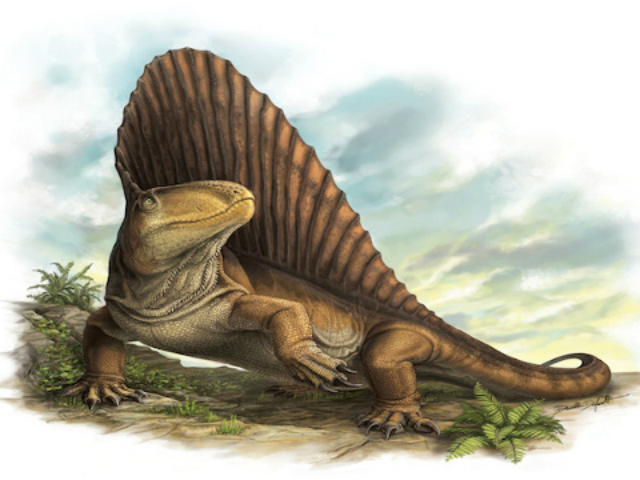Filtered By: Scitech
SciTech
This mammalian relative had steak knives for teeth

Credit: Danielle Dufault, via io9.com
If you’ve ever found yourself wishing that you had a tough-as-nails relative to protect you from bullies, take comfort in the fact that millions of years ago, a very distant cousin of humanity was already terrorizing everything else by (a) looking like a dinosaur even before dinosaurs existed and (b) having freakishly sharp steak knives for teeth.
Mistaken identity: Nope, not a dinosaur
A casual glance at Dimetrodon would lead pretty much anyone to assume that the four-legged, reptilian, 13-foot-long creature was a dinosaur.
It doesn’t help that the animal’s gigantic back fin – believed to have been used to regulate their body temperatures or attract potential mates – gives it a passing resemblance to Spinosaurus, the largest theropod dinosaur discovered so far.
If the name rings a bell, that’s because Spinosaurus was the narrow-snouted predator that totally trashed Tyrannosaurus rex in Jurassic Park 3:
If the name rings a bell, that’s because Spinosaurus was the narrow-snouted predator that totally trashed Tyrannosaurus rex in Jurassic Park 3:
However, Dimetrodon was not a dinosaur; in fact, it would be more accurate to say that it was actually a distant relative of mammals. Living during the Early Permian era (between 298 million and 272 million years ago) in parts of Europe and the United States, Dimetrodon belonged to a family of primitive synapsids (the group comprised of mammals and all animals more closely related to mammals than to reptiles or birds) called pelycosaurs.
While not exactly direct ancestors of mammals, pelycosaurs are essentially a “stem group” of synapsids. Branching out from the main synapsid line, pelycosaurs still carried characteristics that placed them somewhere between mammals and reptiles on the evolutionary map. Pelycosaurs were eventually succeeded by more advanced mammal-like synapsids, called therapsids.
Sporting steak-knife chompers before it was cool
A new study published in the online journal Nature Communications revealed that Dimetrodon, which predated dinosaurs by about 40 million years, had teeth that looked and functioned much like steak knives.
As a result, researchers have determined that the finned meat-eater may have been the first land-based carnivore to develop zyphodont (laterally compressed and serrated) teeth.
“The available evidence indicates that ziphodonty evolved for the first time in the largest known species of the genus Dimetrodon and independently from the ziphodont teeth observed in some therapsids,” wrote the researchers in their paper.
Dimetrodon is believed to have fed on large fish, amphibians, reptiles, other proto-mammals, and even small insects.
“The steak-knife configuration of these teeth and the architecture of the skull suggest Dimetrodon was able to grab and rip and dismember large prey,” said study co-author Robert Reisz, a biologist from the University of Toronto Mississauga, in a press release.
Reisz and graduate student Krisitin Brink looked at specimens that covered over 25 million years of evolution using high-tech equipment such as a scanning electron microscope (SEM).
“Teeth fossils have attracted a lot of attention in dinosaurs, but much less is known about the animals that lived during this first chapter in terrestrial evolution,” explained Reisz. "This research is an important step in reconstructing the structure of ancient complex communities.”
Upon closer examination, the researchers also observed that Dimetrodon possessed cusps – teeth with raised points on the crown, which are found in mammals.
According to Reisz, teeth reveal more about the ecology of animals than simply studying the skeleton. “We already know from fossil evidence which animals existed at that time but now, with this type of research, we are starting to piece together how the members of these communities interacted."
Let’s all take a moment to appreciate our hipster “cousin,” Dimetrodon (and thank our lucky stars that he’s not around anymore). — TJD, GMA News
More Videos
Most Popular



